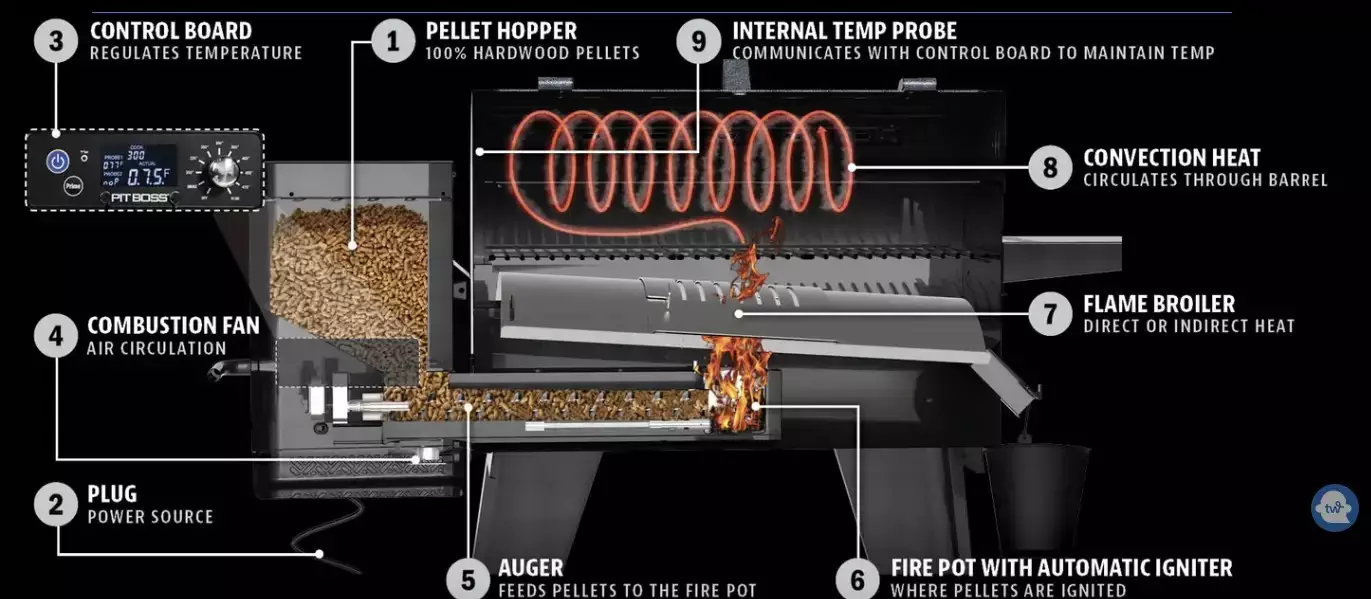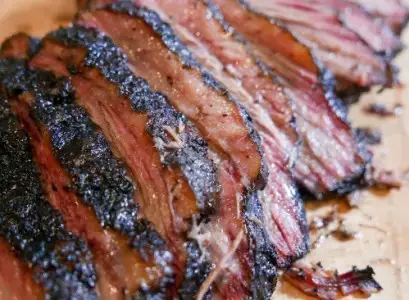This informative article will show you how to smoke meat specifically on a Pit Boss pellet grill. If you have another brand of pellet grill you will still find plenty of useful information, but you’ll need to keep this in mind.

Pit Boss grills are versatile and affordable cooking machines that make smoking meat at home both easy and enjoyable. For those unfamiliar with this grill, it uses wood pellets to provide both heat and impart smoky flavour to your meat, and controls how the pellets ignite so you can easily keep a consistent temperature inside your smoker.
In this article, we will explore the benefits of using the Pit Boss Wood Pellet Grill to smoke your meat, and provide a step-by-step guide to help you achieve the perfect smoky flavor.
Whether you are a beginner or an experienced pitmaster, this article is sure to provide you with valuable insights and tips for smoking meat on the Pit Boss Wood Pellet Grill.
- How to Smoke Meat on a Pit Boss Smoker
- Smoking Meat Basics
- Preparing Your Pit Boss Smoker for Smoking
- The Main Settings on a Pit Boss Smoker
- The Pit Boss Smoke Setting (S)
- Pit Boss P Setting
- Preparing Meat for Smoking on the Pellet Grills
- Putting the Meat onto the Smoker Grills
- How to Know When Your Smoked Meat is Ready
- Resting Smoked Meat
- Related Reading
How to Smoke Meat on a Pit Boss Smoker
Smoking Meat Basics
Smoking meat is a delicious way to add taste and tenderness to your meals. To get started, it helps to understand the smoking process.
This involves smoking meat with wood pellets that are fed into the auger (No.5 in the diagram below) from the pellet hopper (No.1) of your Pit Boss Pellet Grill.
You can control the rate at which the pellets are fed into the auger with the control board (No.3) allowing you to regulate the temperature and keep your smoker consistently at the same temperature throughout the smoking process. If the temperature is higher then the pellets are fed into the firepot faster than if the temperature is lower.
See the diagram below get a better understanding of the each of the different parts of the Pit Boss Grill. It comes directly from Pit Boss themselves on the Pit Boss Australia website.

There are many types of hardwood pellets that you can use for smoking, including hickory, mesquite, pecan, alder, oak, apple, and cherry wood. Each type of wood pellet contributes a unique flavour to the meat, and it can be fun to experiment with the different woods on their own or as a blend.
Some woods pair better with particular meats, but the main thing is make sure that your choice of wood doesn’t overpower the flavour of the food you are cooking. Hickory and particularly mesquite have a robust smoke profile that doesn’t suit more delicate meats or fish.
Preparing Your Pit Boss Smoker for Smoking
When preparing the Pit Boss grill for smoking, it’s essential to follow some safety tips.
Firstly, ensure that the grill is placed on a stable, level surface, away from any flammable items.
Secondly, make sure that the hopper lid is closed before adding the pellets. When starting the grill, remove the grates and heat deflector plate, and ignite the pellets with a match or lighter.
It’s crucial to keep the lid open during ignition to avoid any flare-ups. After ten to fifteen minutes, replace the heat deflector plate and grates, and the grill is ready to be used for smoking.
To control the temperature on the Pit Boss grill, adjust the damper on the exhaust and intake to maintain the desired temperature range. This is often 225-250F or 107-121C.
The Main Settings on a Pit Boss Smoker
Although there is some variation between Pit Boss models, the main settings on the Pit Boss grill controller are 200°F, 225°F, 250°F, 300°F, 350°F, 400°F, 475°F, as well as ‘Smoke,’ and ‘High.’
The Pit Boss Smoke Setting (S)
The Pit Boss Smoke Setting (S) is a feature found on Pit Boss grills that allows for the slow, steady and consistent infusion of smoke into food while it cooks.
This setting is designed to maintain a low temperature consistently over a number of hours.
When the Smoke Setting is selected, the grill’s auger automatically feeds wood pellets into the firepot, where they are ignited to create smoke which then circulates around the cooking chamber of your Pit Boss grill. This smoke helps to flavour and tenderise the food, producing the delicious, smoky taste that is so popular among BBQ enthusiasts.
Starting your Pit Boss grill on the smoke setting (temperature range of 180-200F or 80-100C) helps to ensure that your pellets don’t overload the firepot.
Pit Boss P Setting
The Pit Boss P setting (P for pause) controls how long the grill pauses between cycles of feeding pellets into the firepot.
Depending on the particular P cycle you choose the pause will be longer or shorter, ultimately allowing you to regulate the temperature inside the grill.
If you want to sear your food at high heat or quickly grill things like steaks, burgers or sausages you have that option too.
Preparing Meat for Smoking on the Pellet Grills
When preparing meat for smoking on a Pit Boss Pellet Grill, there are a few things to keep in mind.
First, consider brining the meat overnight in a mixture of salt, sugar and water. Brining isn’t essential but it helps to impart extra flavour and acts as insurance against meat drying out in the smoker.
If you need a brining recipe for poultry, try below.
For a pork shoulder cider brine try here:
Secondly, it’s important to realise that seasoning meat before smoking is key to achieving a tasty end result. Some popular seasoning techniques include BBQ dry rubs or marinades. The longer you leave the meat the more flavour will be imparted.
In terms of choosing the right cuts of meat for smoking, tougher cuts, such as brisket or pork shoulder, are ideal for smoking as the slow cooking process helps to tenderise the meat and break down connective tissue. If you want recipes for for these try below.
Fattier cuts, like beef short ribs or pork belly, also work well for smoking as the fat helps to keep the meat moist during the cooking process. Bear in mind you may need to trim some of the fat cap off before smoking, or get your butcher to do it for you.
Smaller cuts of meat can work really well in your smoker as well. For example sausages, chicken wings, and individual steaks all take on smoke flavour well and won’t take long to cook in your Pit Boss smoker.
To get a nice char on your pellet smoked steak sear it on both sides over high heat at the end of the smoke. Try these recipes below if you want to find out more about smoking these smaller cuts of meat.
Putting the Meat onto the Smoker Grills
Once your meat is seasoned, trimmed, and ready to go, the next step is to place it on the grills of your Pit Boss Pellet Grill.
It’s important to leave enough space between the pieces of meat to allow for air circulation and to prevent them from sticking together. Some people prefer to use a rack or basket to elevate the meat and allow smoke to circulate around it.
To ensure even cooking you’ll need move the meat at least once during the smoking process, especially if it’s going to be in the smoker for a long time.
Another important consideration when smoking meat is the use of a drip tray to catch any excess fat or juices that may drip off during cooking. Your Pit Boss grill comes with a steel bucket to catch any grease, but you may wish to consider using a drip pan to collect meat juices that can be used for stocks or sauces.
A drip pan can help prevent flare-ups and keep the grill clean.
It’s also worth considering adding moisture to the meat during smoking to prevent it from drying out.
You can do this in 2 main ways; by adding a waterpan (a foil tray filled with water) to the smoker or spritzing or mopping the meat with apple juice, stock, apple cider vinegar or a little butter or oil. Some people use a mixture of these liquids as well.
If you are smoking large cuts of meat such as a rack of ribs, pork butt or brisket you’ll need to wrap them in foil or butcher’s paper for the second stage of the smoke and add liquid at that point.
How to Know When Your Smoked Meat is Ready
The exact timings for smoking meat will be different on every smoking occasion, so the only way to know for sure if your smoked meat is ready to eat is to carefully monitor its internal temperature.
A digital thermometer is a really worthwhile investment here.
Each meat you smoke will have a different target temperature to aim for. Check out the link below for a free printable download telling you lots of helpful information about what temperature to smoke at and what internal temperature to aim for.
Resting Smoked Meat
While it would be easy to leave out this step in the smoking process, it is an essential one.
Resting your BBQ smoked meat helps the meat relax and allows the juices to redistribute throughout the connective tissues, making for a more tender and moist result.
Larger cuts of meat such as brisket will need a longer rest time, but 5-10 minutes is enough for most meats.
Related Reading
- The Best Meats to Smoke
- Quick and Easy Smoker Recipes
- Pellet Grill Recipes for Steak
- How to Smoke Salmon in a Pit Boss Smoker
- Pit Boss Recipes


